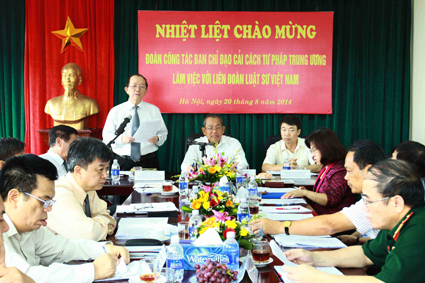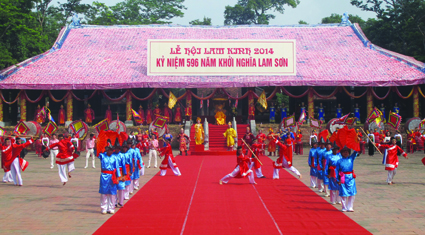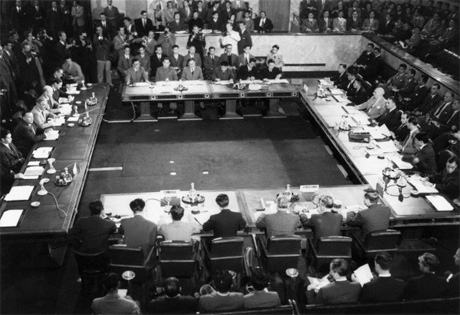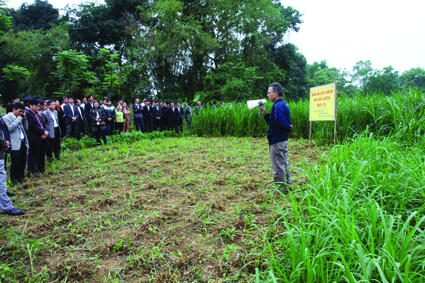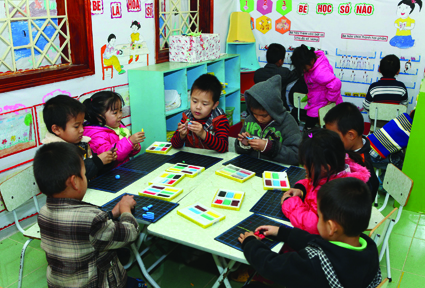Hoang Minh Khoi
Administrative Academy, Ho Chi Minh City
Protection and guarantee of children’s rights in labor relations
Article 35 of the 2013 Constitution stipulates: “Discriminatory treatment, forced labor or employment of people below the minimum working age is prohibited.” This stipulation is established based on two parallel lines: protection and guarantee.
While adults have the right as well as obligation to work, minors[1], especially children[2], just have the right to work, and this right needs to be protected. On the one hand, the Constitution prohibits all persons, organizations and agencies from using any forms of forced labor against minors and from employing minors who are “below minimum working age.” Under the Labor Code (Clause 1, Article 3), the current minimum working age is full 15 years. On the other hand, as children have the right to work, the Constitution acknowledges their right in certain labor relations[3], namely the right to choose to participate in activities that bring about material or spiritual benefits to themselves, families and society suitable to their personal capabilities and legal conditions. These activities may include circus, music, cinematography, theater and other artistic work. This constitutional acknowledgment or protection of this right of children also aims to enable them to express their talents and aptitudes right at early age.
 |
| The Vietnam Association for Protection of Children’s Rights gives presents to disadvantaged children in Cho Don district, Bac Kan province__Photo: Nguyen Thuy/VNA |
Working children are subjects of labor law and entitled to the legal guarantee that nobody may use illegal approaches to deceive or force children to work against their will and that all negative discriminatory treatments against the dignity, honor and health of children in labor relations are regarded as serious violations of law. This legal guarantee is clearly stipulated in Article 35 of the 2013 Constitution.
It can be said that protection and guarantee of children’s rights in labor relations constitute a novel legal institution compared to the previous constitutions and conform to the general trend of development of modern men. Today, minors and children have the chance to live and grow under material as well as scientific and technological conditions much more developed than before. Their excelling mental and physical abilities require an environment for their earlier participation in social activities and development of their talents and skills under the protection and guarantee of the constitution and laws. This institution in the 2013 Constitution is in full conformity with the international conventions on employment of child labor.[4]
Protection and guarantee of children’s rights in marriage and family relations
Marriage and family are always regarded as the underpinning traditional moral values of the nation. Happy marriage is central to any family; happy families create a stable and developed society, which in turn serves as a practical basis for happy marriage and family in which the care for and protection of children are the basic core. Our constitutional history proves that this inherent relationship has always received the attention and protection of the State.
The 1946 Constitution adopted simple but succinct legal norms for the establishment of voluntary and progressive marriage relations: “Females enjoy equal rights as males in all aspects” (Article 9). Especially, it enshrined children’s rights to be cared for and raised and to learn: “children are entitled to be cared for in education and nurturing” (Article 14) and “a compulsory and free primary education…; poor pupils are entitled to the Government’s assistance” (Article 15).
The second Constitution, enacted in 1959 when the country was divided into two regions, inherited and developed the provisions on protection of the interests of mothers and children and reaffirmed the protection of marriage and families (Article 24).
The 1980 Constitution was seen as the pinnacle of state protection of marriage and family and children’s rights. It established legal bases for “the family to be a cell of society.” Parents have the duty to raise and teach their children into useful citizens of the society and the State does not recognize discriminatory treatment among children (Article 64). The State and society attach great importance to protecting, caring for and educating adolescents and young children and gradually expand the assumption of the responsibility to raise and teach children to guarantee their learning and growth.
The 1992 Constitution and its 2001 amendments are a replica of almost all the 1980 version’s provisions on the protection of marriage and family (Articles 63, 64, 65 and 66), especially children’s rights to live, grow, develop and learn under the care of the family, the State and society.
Following the 1992 Constitution, the 2013 Constitution continues affirming the protection of marriage and family relations and children’s rights on the principles of “voluntariness, progressiveness, monogamy, equality and mutual respect between husband and wife; protection of the interests of mothers and children” (Article 36). It can be said that the 2013 Constitution not only establishes the basic traditional values but also expresses them in a simple, succinct and highly general language.
The affirmation in the 2013 Constitution that “the State shall protect marriage and family and the interests of mothers and children” also means that in a society that is led by a law-ruled state, all of its constituents are guaranteed by law to exist and develop. Protecting marriage and family is also guaranteeing the rights and obligations of entities in legal relations on marriage and family. In these relations, parents have the responsibility to raise, teach and educate their children; the State and society must pay attention to guaranteeing the interests of mothers and children. Children and grandchildren, when becoming mature and having conditions, have the duty to respect and look after their parents and grandparents. The above contents are all traditional values; therefore, once the legal institution on protection and guarantee of marriage and family relations is established, it naturally embraces the endorsement of these values and, therefore, the expression of these values in separate legal norms is unnecessary.
Protection and guarantee of children’s rights in substantive and procedural legal relations
Article 37 of the 2013 Constitution stipulates: “Children shall be protected, cared for and educated by the State, family and society; children may participate in child-related issues. Harassing, persecuting, maltreating, abandoning or abusing children, exploiting child labor or other acts that violate children’s rights are prohibited.”
So, in addition to the protection of children’s rights in labor, marriage and family relations, the 2013 Constitution has established a mechanism for protecting and guaranteeing children’s rights in almost all social relations. Prohibition is a compulsory legal command that creates the legal possibility for the application of measures to prevent and preclude all manifestations that are inappropriate or contrary to it, which are anticipated to cover at least six specific acts: “harassing, persecuting, maltreating, abandoning, abusing and exploiting.” These provisions also serve as a basis for creating legal institutions on children’s rights in administrative, criminal, civil and labor procedure laws.
In most cases, minors and children do not enjoy all of citizens’ rights when participating in social relations, but depending on their age, they may be recognized by law to have act capacity in a number of social relations under certain conditions.[5] They are, however, vulnerable to abuse, incitement and deception into performing illegal jobs or easily fall victims to discriminatory treatment, persecution, exploitation and other illegal acts. So, the 2013 Constitution has put forth the institution “prohibition” or, to put in another way, the supreme legal protection and guarantee for the protection of children’s rights in all legal relations. In the 1992 Constitution, this institution was reserved for women only: “All acts of discriminatory treatment against women and hurting their dignity are prohibited” (Article 60).
Additionally, Clause 3, Article 103 of the 2013 Constitution stipulates that people’s courts shall hold their hearings in public but “in a special case which requires protection of state secrets, conformity with the fine customs and traditions of the nation, protection of minors or protection of private life and at the legitimate request of an involved party, a people’s court may hold a closed hearing.” Though this stipulation does not directly govern and is not compulsory for the protection of the rights of minors in legal proceedings and its application is at the discretion of courts, it does establish a principle for trial activities containing protection of minors to shelter them from unnecessary mental harms when participating in court hearings.
Closed hearings were required in certain cases by the 1992 Constitution (Article 131) and these cases were specified in the 2003 Criminal Procedure Code (Article 18). However, these documents made no mention to closed hearings for cases involving minors. The new Constitution has included minors in the group of entities to which this special procedure is applied. This shows greater responsibility of the State to future generations and conforms to the international convention on children’s rights[6]. It is the constitutional basis for the revision of the Criminal Procedure Code concerning this issue.
Vietnam joined very early the United Nations Convention on the Rights of the Child and has been an active and responsible member of many other international commitments concerning the protection and guarantee of the fundamental rights of children, such as the right to survival and development in their best interests, the right to participate, and the right to protection from exploitation and abuse. In our legal system, the handling of juvenile delinquents is primarily aimed at education and creation of conditions for them to be aware of their wrongdoings and mistakes and determined to reform themselves. This view has been consistently demonstrated in the 1980 and 1992 Constitutions and concretized in various laws, such as the 2001 Law on Marriage and Family (Article 37) and the 2004 Law on Protection of, Care for and Education of Children (Article 58). The 2012 Law on Handling of Administrative Violations (Article 134) and the 1999 Penal Code (Article 69) provide separate principles for the handling of juvenile delinquents. Yet, our legal system does not yet have a separate judicial system applicable to minors; the protection and guarantee of children’s rights in the current procedural laws remain unspecific and unclear. Therefore, the 2013 Constitution stipulates: “Children have the right to participate in children’s issues” - a totally new provision that meets the urgent requirement of improving the legal system and creates a basis for the establishment and development of a juvenile justice system. The new Constitution has elevated the protection and guarantee of children’s rights to a new height, enabling children to not only voice their demand for better living conditions but also exercise the right to self-protection, criticism and rejection as well as the right to request necessary assistance to object to unfavorable charges even when they are offenders.
In order to well implement the legal institutions enshrined in the 2013 Constitution related to children’s rights in the context of building a law-ruled state, we should continue to substantially revise child-related provisions of the labor, civil, administrative and criminal procedure laws. Particularly for legal relations involving minors, the author would like to put forward the following solutions and recommendations:
Firstly, the justice system, in a broad sense, is understood to cover not only trial activities of courts but also particular mechanisms to enforce judgments or settle disputes, which are currently implemented in a prudent manner in our country in the judicial supplement system[7]. These mechanisms are necessary for dealing with the existing difficulties and workload of the system of courts and administrative-justice agencies. To follow this model, a judicial supplement mechanism should be introduced to enforce competent agencies’ decisions on application of handling measures against juvenile offenders. This could involve social organizations or persons assigned by the State to protect, manage and educate juvenile offenders under the control of a specialized state agency.
Secondly, administrative handling measures against juvenile delinquents prescribed in the Law on Handling of Administrative Violations and “judicial measures” and “judicial measures applicable to juvenile criminal offenders” prescribed in the Penal Code should be consolidated into a Law on Judicial Measures as most of these measures are similar in content and form of implementation.
The Law on Handling of Administrative Violations introduces alternative measures applicable to juvenile delinquents, namely caution and family-based supervision, and adolescents and children against whom these measures are applied are not regarded as law offenders. This can be seen as a new humanitarian development that enhances the responsibility of family and community and, therefore, these measures should also be moved to the above-said Law on Judicial Measures.
Thirdly, a system of courts for adolescents and children should be established. In the immediate future, in order to overcome difficulties in manpower and physical facilities of courts in the application of judicial measures and the overlap between the aforesaid administrative and judicial measures, a mechanism should be created after the judicial supplement model, whereby the State would authorize this work under certain conditions to a council for application of judicial measures. The court should preside over this council and authorize “contractual judges” to consider and decide on the application of judicial measures. These “contractual judges” could be selected from those who are qualified to carry out judicial activities, such as people’s assessors, judicial officers, members of lawyers’ associations and member organizations of district- and commune-level Vietnam Fatherland Front Committees. They should be volunteers who satisfy recruitment criteria, receive professional training for 3 to 6 months and possess certificates of training in judge’s skills. Chief justices of district-level people’s courts would sign authorization contracts with the councils and appoint council heads for each specific case. Each council should be composed of three members. Within three days after the council issues a decision to apply or not to apply a judicial measure, this decision should be approved by the chief justice of the district-level people’s court. This approval aims to ensure the legality of the council’s decision. In case the chief justice does not agree with the council’s decision, he may negotiate with the council for appropriate revision.
This mechanism could be implemented for 5-10 years to draw experiences while building up human resources and physical facilities for establishing tribunals for adolescents and children.
In the long term, a system of tribunals for adolescents and children should be set up with reference to experiences of juvenile courts in other countries like Canada, the U.K, etc. These tribunals should be organized at two levels, provincial and district, to try minors who commit criminal offenses or administrative violations. These tribunals should not be administratively dependent on the people’s courts of the same level but be placed under the management of the Supreme People’s Court.
Finally, to build a juvenile justice system does not only mean building a fair and appropriate adjudication system. A national committee for adolescents and children’s affairs should be set up like a ministry. Its basic duties would be taking care of and managing normal young people, juvenile delinquents and potential delinquents. It would be composed of specialists in education, health, sports, psychology and other relevant areas who are familiar with minors’ issues and be assisted by an appropriate judicial assistance force focusing on caring for and protecting minors.-
[1] The 2005 Civil Code (Article 20): “Minors are persons under full 18 years.”
[2] The 2004 Law on Protection of, Care for and Education of Children (Article 1): “Children referred to in this Law are Vietnamese citizens under 16 years.”
[3] The 2013 Labor Code stipulates the principles of employment of minors: “Employment of minors is prohibited in heavy, toxic and dangerous jobs or in workplaces or jobs which may adversely affect their personality, as determined in the list issued by the Ministry of Labor, War Invalids and Social Affairs in coordination with the Ministry of Health.”
[4] Convention No. 138 of the International Labor Organization on the minimum age for admission to Employment (Article 2): “The minimum age shall not be less than the age of completion of compulsory schooling and, in any case, shall not be less than 15 years… However, a Member whose economy and educational facilities are insufficiently developed may, after consultation with the organizations of employers and workers concerned, where such exist, initially specify a minimum age of 14 years.”
[5] The 2000 Marriage and Family Law stipulates: “Children of between full 15 years and under 18 years have the right to disposition to their own property (Article 48); “The adoption of children of 9 years or older is subject to their consent” (Article 71); and “The change of family or given names of adopted children of 9 years or older is subject to their consent “ (Article 75);
The 2012 Labor Code: “1. Workers are persons of full 15 years or older,...” (Article 3);
The 2012 Law on Handling of Administrative Violations: “Persons subject to administrative sanctions include: persons of between full 14 years and under 16 years who are administratively sanctioned for…” (Article 5);
The 1999 Penal Code: “Persons aged full 16 or older shall take penal responsibility for all crimes. Minors aged between full 14 and under 16 shall take penal responsibility for very serious crimes committed intentionally…” (Article 12).
[6] The United Nations Convention on the Rights of the Child: “No child shall be subjected to arbitrary or unlawful interference with his or her privacy, family, or correspondence, nor to unlawful attacks on his or her honor and reputation” (Article 16). 7 Notarization and bailiff services…
[7] Notarization and bailiff services…
